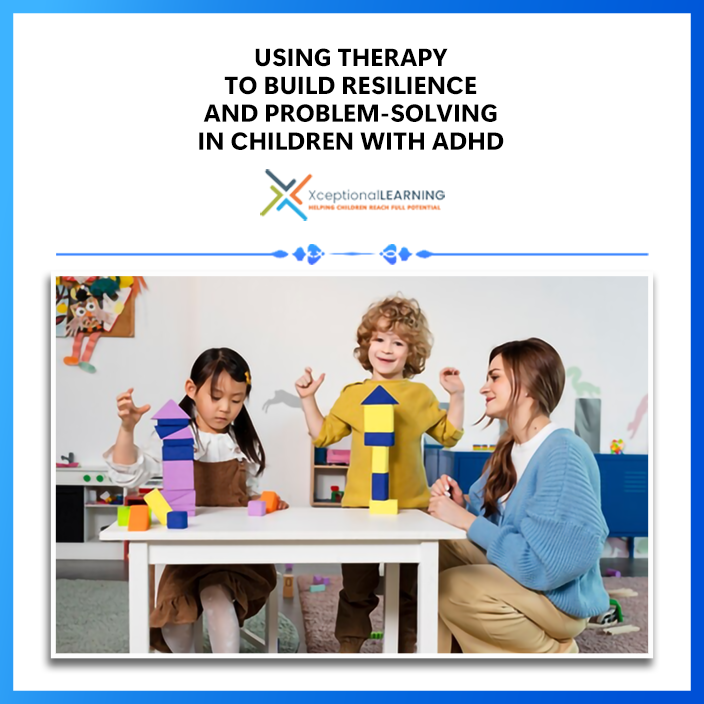Using Therapy to Build Resilience and Problem-Solving in Children with ADHD
admin June 25th, 2025

Attention-Deficit/Hyperactivity Disorder (ADHD) affects millions of children worldwide. These children often face unique challenges, including difficulty focusing, controlling impulses, and managing emotions. But beyond these hurdles lies a crucial area that parents, educators, and therapists must address—building resilience and enhancing problem-solving skills. Therapy can play a transformative role in empowering children with ADHD to handle everyday struggles with confidence and clarity. This blog explores how different therapeutic approaches help children with ADHD develop the resilience and problem-solving strategies they need to achieve.
Understanding ADHD: The Foundation
ADHD is a neurodevelopmental disorder characterized by:
- Inattention: Difficulty sustaining focus, forgetfulness, disorganization.
- Hyperactivity: Constant movement, restlessness, inability to sit still.
- Impulsivity: Acting without thinking, interrupting others, emotional outbursts.
While medications like stimulants can be effective, they are often complemented by behavioral, occupational, and psychological therapies that provide children with the tools to regulate their behavior and emotions.
But where does resilience fit in?
What is Resilience—and Why is It Important?
Resilience is the ability to bounce back from challenges and adapt positively to adversity. For children with ADHD, resilience can mean the difference between internalizing failures or pushing forward with strength and confidence.
Why Children with ADHD Need Resilience:
- They face frequent academic and social difficulties.
- They often experience negative feedback from peers and adults.
- They are more prone to emotional dysregulation and frustration.
Without resilience, children with ADHD may struggle with low self-esteem, learned helplessness, and anxiety. Therapy helps by retraining the brain to think constructively, manage setbacks, and view challenges as learning opportunities.
The Link Between Resilience and Problem-Solving
Problem-solving is a key component of resilience. It involves identifying challenges, generating solutions, weighing outcomes, and acting decisively. For children with ADHD, who often struggle with executive function, therapy can:
- Break tasks into manageable parts.
- Reinforce cause-and-effect thinking.
- Encourage alternative strategies when faced with failure.
Together, resilience and problem-solving create a foundation for adaptive coping skills.
Therapy Approaches that Support Resilience and Problem-Solving
1. CBT helps children reframe negative thoughts and develop effective coping strategies.
Cognitive Behavioral Therapy (CBT) is a structured and evidence-based approach that supports children in identifying unhelpful thinking patterns and replacing them with more balanced thoughts. It also teaches emotional regulation, planning, and reflection—vital for resilience and problem-solving.
- Example: A child struggling with schoolwork might often say, “I always mess up.” Through CBT, the therapist guides the child to reframe that belief into, “I’m learning, and I can try a different way.” Over time, this helps build self-confidence and persistence in facing challenges.
2. Play Therapy allows children to express emotions and explore solutions through imaginative play.
Children often don’t have the words to describe how they feel, but they naturally express themselves through play. Play Therapy creates a safe space where children can act out scenarios, practice emotional control, and learn new ways to handle problems.
- Example: A child who has trouble sharing may use dolls in a session to role-play giving and taking turns. The therapist gently introduces the idea of fairness and empathy, helping the child apply those lessons in real life.
3. Occupational Therapy improves focus, independence, and goal-setting through structured activities.
For children with ADHD, managing time, staying organized, and handling sensory input can be difficult. Occupational Therapy (OT) supports development in these areas through engaging, goal-directed tasks that enhance both motor and cognitive abilities.
- Example: A therapist might work with a child to organize their school bag each day using a picture checklist. This simple routine helps build planning skills, self-reliance, and a sense of accomplishment.
4. Social Skills Training equips children with tools for healthy relationships and emotional control.
Children with ADHD may find it hard to read social cues, wait their turn, or handle rejection. Social Skills Training provides a structured environment to learn, practice, and apply social strategies in peer interactions.
- Example: In a small group session, children take turns practicing how to start a conversation. With support, they learn to make eye contact, listen, and respond appropriately—skills that make social situations less overwhelming and more rewarding.
5. PCIT strengthens emotional security by coaching parents in supportive communication and discipline.
Parent-Child Interaction Therapy (PCIT) is designed to strengthen the bond between parents and children by enhancing communication and positive interactions. Through real-time coaching, parents learn to set clear boundaries while staying connected and responsive, creating a safe and consistent environment for the child.
- Example: During a play session, a therapist observes from behind a one-way mirror and guides a parent through an earpiece to use calm praise and ignore minor misbehavior. Over time, this helps the child feel understood, reduces outbursts, and reinforces emotional resilience.
Everyday Strategies to Reinforce Therapy
- Promote a Growth Mindset: Encourage learning from mistakes and praise effort over results.
- Stick to Routines: Use visual schedules and clear expectations to reduce stress.
- Teach Problem-Solving Steps: Guide children through identifying problems and testing solutions.
- Model Resilience: Share your own coping strategies to inspire positive behavior.
The Role of Schools and Community Support
Schools play a critical role in supporting therapy goals. Individualized Education Programs (IEPs) or 504 plans should include goals for emotional regulation, organization, and social interactions. Community resources such as support groups, mentoring programs, and after-school clubs also offer children with ADHD opportunities to practice resilience and decision-making. Collaboration between therapists, parents, teachers, and the child creates a circle of support that reinforces therapeutic growth.
The Technology Advantage: Digital Therapy Tools
Modern therapy is evolving with technology, and platforms like XceptionalLEARNING (XL) are leading the way in making therapy more engaging, accessible, and effective for children with ADHD.
- Digital Activity Book: XL’s interactive Digital Activity Book offers engaging, age-appropriate exercises that help children practice problem-solving, executive functioning, and emotional control in a fun and structured format.
- Gamified Learning Modules: The platform uses reward-based games and interactive tasks that encourage persistence, critical thinking, and motivation—turning therapy into an exciting experience.
- Progress Tracking & Reports: XL equips therapists and educators with real-time progress tracking, allowing data-driven decisions and personalized therapy plans.
- Parent & Educator Access: With secure access, caregivers and teachers can reinforce therapy goals at home or in the classroom, creating a seamless support system around the child.
By integrating platforms like XceptionalLEARNING, therapy becomes more than a weekly session—it becomes a continuous, child-friendly experience that empowers children to build resilience and problem-solving skills every day.
Conclusion: Turning Struggles into Strengths
Children with ADHD are bright, creative, and capable—but they often need structured support to navigate the world confidently. Therapy is more than a treatment; it’s a launchpad for resilience and lifelong skills. By combining therapeutic techniques, parental involvement, educational support, and digital tools, we can help children with ADHD not just survive—but grow. If you’re looking for innovative ways to support your child’s development, explore XceptionalLEARNING—offering comprehensive Child Development Support and a variety of expert-created therapy resources designed to build essential skills in a fun and engaging way. Our Intensive Therapy Services offer focused support tailored to the unique developmental needs of children with ADHD, helping them make faster, measurable progress. Contact us today for a free demo and discover how our solutions can empower children with ADHD to become resilient, confident, and independent problem-solvers through engaging tech-enabled therapy.

